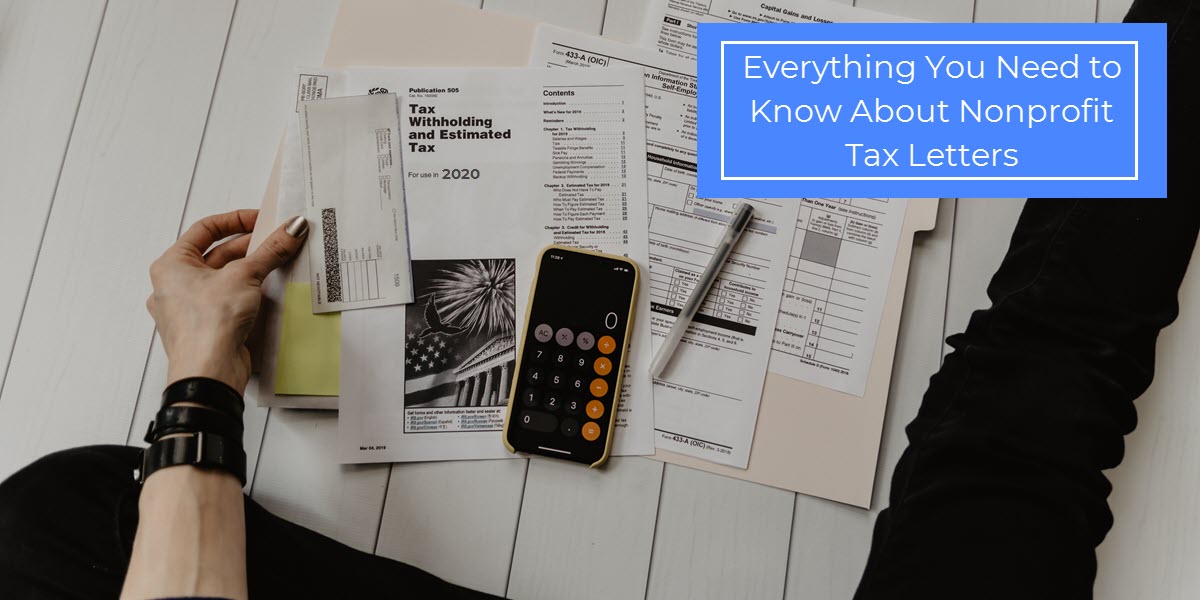Nonprofit Technology & Fundraising Blog
Subscribe to our mailing list
December 16, 2020 |

Ready to ring in the new year? When the holidays are finally over you can breathe a sigh of relief and finally relax. That is until you realize it’s January and you have to mail out your annual nonprofit tax letters to donors before the end of the month. Sending your donors their end-of-year annual giving summary doesn’t have to be hard, though. We’ve simplified it for you here, making sure you know what to include and what to leave out of your donor’s annual statements.
The IRS provides clear and simple directions for donors in the US on how to claim tax-deductions for charitable giving. What they will need from you, the nonprofit they donated to, is a written document (an email or letter) that includes the three following elements:
Now, let’s take a closer look at what tax season looks like for your donors and how YOU can help your supporters even further.
Your donors may know how much they’ve donated to you this year. You may even have a very organized donor who has kept all of the thank you letters you have sent them throughout the year for individual gifts. That’s a great start! But let’s say your donor attended one of your events and paid for tickets to attend. If the cost of the ticket included a dinner, drinks or some other benefit, the full cost of the ticket price may not be tax deductible.
Chances are your donor does not know the fair market value of their ticket purchase. Fortunately, with DonorPerfect, there is an easy option to only include the partially tax-deductible amount of any gift. Include the tax-deductible amount field in your end-of-year letter to do the math for your donors, making their life a little bit easier.
You CANNOT thank your volunteers enough. They are an invaluable resource to your organization. The end of the year should be a time to recognize them for all the hard work they dedicate to your organization.
Unfortunately, the IRS cannot provide any tax benefits to your volunteers. There are too many variables that make it impossible to assess the value that a volunteer has contributed to your organization accurately. However, if your volunteer purchased any items to fulfill a service to your organization, the out-of-pocket costs for the materials they used and purchased is tax deductible.
While the IRS cannot recognize the value of your volunteers, it is vital that you do. So make the end of the year a time to send out a special thank you to these loyal supporters.
While your bookkeeper or accountant will note a pledge promised within the calendar year, the IRS will not consider this donation tax deductible until paid. You can include your donors’ pledge payments in their tax-deductible amount, but not any portion of the pledge that is yet unfulfilled.
Pro Tip: If you’re running financial reports, make sure pledge payments and gifts are the only sources of revenue being totaled.
The donor-advised fund that your supporter used to facilitate the contribution will send your donor the information they need for their taxes. So, while it is indeed a tax-deductible gift, that information will not come from your nonprofit.
That being said, you should absolutely still thank your donors for these types of gifts. You can simply exclude the 501 c(3) information that you would typically send.
In-kind gifts are tax-deductible, and the IRS makes your job easy. Valuing the in-kind donation is not the responsibility of the non-profit. Instead, provide your donor with a document that includes the date the donor contributed the gift along with an accompanying description of the donation. With DonorPerfect, you can record in-kind donations and include them in your end-of-year tax letters in a flash.
This one might surprise you. Purchased raffle tickets and tickets associated with fundraisers like bingo are NOT tax-deductible.
Pro Tip: Since these purchases still contribute to your annual fundraising goals, make sure you record them in your database. To ensure that you do not total these gifts in a donor’s tax-deductible amount, make sure the Fair Market Value is equal to the purchase price of the tickets.
This one is a mixed bag. The general rule of thumb is that if your donor receives benefits in exchange for dues, the membership dues are NOT tax-deductible. There are some exceptions to this rule, though:
Pro Tip: Intuit provides an additional exception to these rules if your membership benefits package includes tickets to athletic events.
Ultimately, it is your donor’s responsibility to know what they can and cannot itemize for a tax-deduction, but assisting your donors with a list of their tax-deductible gifts should make tax time a little more bearable when they sit down to crunch the numbers.
Year-end tax letters are a great way to maintain lasting relationships with your donors when you consider them an opportunity to reiterate your gratitude for your donors’ support and generosity.
Have any of your own tips on sending out the perfect nonprofit tax letter? Share in the comments below. We would love to hear from you.
For more year-end resources, check out DonorPerfect’s Year-End Fundraising Hub. When you’re ready to get started with your end-of-year emails and letters, register for DonorPerfect’s Support Spotlight webinar for easy, hands-on instructions.

Follow us on social!